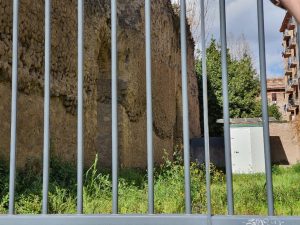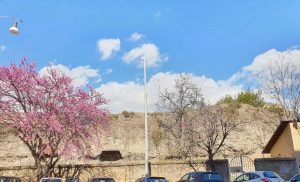This week, PhD student Summer Courts will be collaborating with Dr Sophie Beckett and Cranfield University’s Forensic Institute to continue her research on the two Early Medieval individuals from Lowbury Hill. These two people, one male and one female, have had vastly different stories told about them. The man, who was buried under a mound with a variety of weapons and other grave goods has been interpreted as an Anglo-Saxon warrior, as displayed in the Oxfordshire Museum, Woodstock. Conversely, the woman who was buried in the line of the Roman-period enclosure wall on the site has been viewed as a human sacrifice or a victim of facial mutilation.
During a previous visit to Cranfield, Summer studied the bones of the Lowbury Lady in order to create a biological profile (sex, age, stature, and health assessment) and investigate claims surrounding her death. Careful analysis revealed that the Lowbury Lady may not have been as old as initially reported, with several aging methods revealing an age between 30 and 45-years-old. Additionally, we learned that the woman would have stood between 5’ 3’’ and 5’ 5’’ tall. Examination of skull revealed no traces of a violent death, but did show that many of the fractures to her cranial bones would have occurred after death due to the compressive force of the earth beneath which she was buried. This is evidenced by the angle of the fractures and the staining of the bone exposed by the breaks, which is the same colour as the external bone surface. Fresh breaks are usually lighter in colour than the external bone surface and peri-mortem fractures have a different appearance than older fractures.
This week will see Summer continue her work on the Lowbury Lady by selecting samples for destructive analysis. Samples from the woman’s teeth will be sent to the Scottish Universities Environmental Research Centre in Glasgow for strontium and oxygen isotope analyses which will reveal where she grew up and answer questions about whether or not she was local to the area around Lowbury Hill, Oxfordshire. Summer will also send bone samples for carbon and nitrogen isotope analysis to gain insight into the types of food the woman was eating. Finally, the Lowbury Lady’s temporal bone (the part of the skull near the ear) will be sent to Germany for a DNA analysis in collaboration with Dr Stephan Schiffels at the Max Planck Institute for Evolutionary Anthropology so that we can find out more about her ancestry and any diseases she may have had.
Over the next week Summer will also be selecting samples from the Lowbury Man for destructive analysis. Previous analysis by Cranfield University MSc student Harriet Bryant-Buck has shown that Lowbury Man was 45+ years of age at death, stood between 5’ 5’’ and 5’ 10’’ and grew up in Western Cornwall or the somewhere along the western coast of Ireland. Summer will also be sending a portion of the Lowbury Man’s temporal bone (the part of the skull near the ear) to Germany for aDNA analysis. The temporal bone has been selected for sampling as the bone that forms the petrous portion of the temporal is extremely dense and is more likely to retain traces of DNA than other, less dense bones.
This research, which has been generously funded by the AHRC via the South, West and Wales Doctoral Training Partnership, will give us a wealth of new information about the Lowbury duo and will begin to allow us to tell their stories in a more holistic and nuanced way than before, providing a window on the real lives of these two individuals from our early medieval past.






















